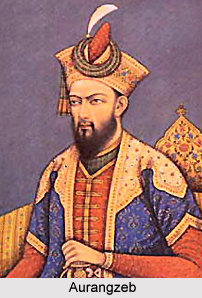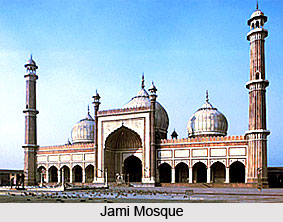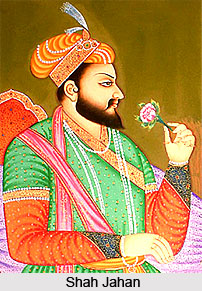 During Aurangzeb, architecture of Delhi had suffered a sudden setback of lack of grandeur and magnificence. Under the earlier Mughals the emperor had served as the `model patron`; it was the nobility who generally regarded the type of structures he built and the styles he favoured as the ideal to emulate. Under Aurangzeb, and especially under his successors, that changed. There was no presence of self-motivated or vibrant imperial patron, so the nobility and other classes built independently of strong central direction, often employing styles and motifs that still reverberated in those established during Shah Jahan`s reign.
During Aurangzeb, architecture of Delhi had suffered a sudden setback of lack of grandeur and magnificence. Under the earlier Mughals the emperor had served as the `model patron`; it was the nobility who generally regarded the type of structures he built and the styles he favoured as the ideal to emulate. Under Aurangzeb, and especially under his successors, that changed. There was no presence of self-motivated or vibrant imperial patron, so the nobility and other classes built independently of strong central direction, often employing styles and motifs that still reverberated in those established during Shah Jahan`s reign.
Architecture in Delhi during and under Aurangzeb thus also had wholly come under the umbrella of `later Mughal-ish` architecture beginning from the man himself. Aurangzeb was much less involved in architectural production as opposed to his predecessors, but he did sponsor imperative monuments, especially religious ones. Most notable are mosques that date prior to the court`s shift to the Deccan. On Aurangzeb`s palace mosque one might witnesses an elaboration of floral and other patterns derived from those on Shah Jahan`s palace pavilions. But these forms are no longer intended to suggest the semi-divine character of ruler, a notion that little concerned Aurangzeb.
Early during Aurangzeb`s reign the harmonious balance of Shah Jahani-period architecture was rejected in favour of an increased sense of spatial tension with a special accent on height. Stucco and other less expensive materials assaying to equal the marble and inlaid stone of earlier periods covered built surfaces. Immediately after Aurangzeb`s accession, the use of forms and motifs such as the baluster column and the bangala canopy, earlier reserved for the ruler alone, are found on non-imperially sponsored monuments, most prominently in the architecture of Delhi. This suggests both that there was relatively little imperial intervention in architectural patronage and that the idiom and expression of imperial and divine symbolism established by Shah Jahan was depreciated by Aurangzeb. It is an authentic and deep-rooted fact that architecture in Delhi during Aurangzeb, as also the architecture of the outskirts of the Delhi regional capital, was verily rested in the intelligent hands of the noblemen and viziers, by now nearly autonomous in nature.
 To begin with, architecture in Delhi under Aurangzeb as an emblem of Mughal dynastic architecture in Delhi, was started out from Lahore and its road leading towards the Indian capital. Yet, a reality remains that although Aurangzeb had erected his largest mosque in Lahore, he rarely had visited the city. Architecture in Lahore and its way leading towards the magnificent Imperial capital state of Delhi, was primarily based upon noblemen and their further entourage, who had endeavoured to erect independent tombs and commemorating grounds, yet again, emulating the once Mughals.
To begin with, architecture in Delhi under Aurangzeb as an emblem of Mughal dynastic architecture in Delhi, was started out from Lahore and its road leading towards the Indian capital. Yet, a reality remains that although Aurangzeb had erected his largest mosque in Lahore, he rarely had visited the city. Architecture in Lahore and its way leading towards the magnificent Imperial capital state of Delhi, was primarily based upon noblemen and their further entourage, who had endeavoured to erect independent tombs and commemorating grounds, yet again, emulating the once Mughals.
Delhi`s architecture under an aloof Mughal Aurangzeb mostly applauds his contemporaries from the Mughal bloodline or his noblemen and ministers. Although Delhi had suffered three major fires in 1662, it was mostly the underprivileged, living in crowded conditions, who were affected, while the spacious mansions of the wealthy, modelled on the imperial residence, survived well. New mansions were built in Delhi during Aurangzeb`s reign, while those erected earlier under Shah Jahan also continued to be utilised, but not necessarily by the same family. Once a noble had expired, as a consequence to which his house had become state property and was bestowed upon the next inhabitant by the ruler himself. For example, after the leading noble Ali Mardan Khan had passed away, Aurangzeb had awarded his mansion to Jahan Ara, in rarest of rare instances coming out from his cocoon and lending some stress upon his architectural potential and prospective. Quite efficiently, thus, Mughal architecture in Delhi under Aurangzeb had, at times, lay upon the royal and blue-blood of the dynasty identified as the `Mughals`.
 In spite of Aurangzeb and his overshadowing presence in the ongoing Mughal realm, Shah Jhana`s architectural and auspicious shadow never had washed away from the then Indian scenario. The Shahjahanabad that Shah Jahan had gifted to his countrymen was one that could never be erased. As such, the greatest of architecture in Delhi during Aurangzeb was accomplished within this walled and fortified city, possessing imposing eight entryways. There was, as such, little architectural activity far south of the walled city of Shahjahanabad. Yet, there also existed the fact that colossal darwazas (doors) were donated at the tomb of Amir Khusrau in the dargah of Nizam ud-Din Auliya in nearby Delhi during Aurangzeb`s reign. But most building was concentrated close to the western part of the walled city, in proximity to its Lahore and Ajmeri gates. The mosque and tomb of Nasir Daulat, erected in 1658 but no longer surviving, were just outside the city`s now-demolished Lahore gate. Inside the city walls, between the Lahore and Ajmeri gates, the Anarwali mosque was built by a pious lady. This mosque as well as the mosque of Khalil, just inside the Ajmeri gate, still stand, although they have been considerably remodelled. The mosque of Khalil, dated 1698-99, is an instance of a single-aisled three-domed structure, situated on a high raised plinth with shops beneath, a striking characteristic in architecture of Delhi under Aurangzeb, never seen previously. Small mosques such as this, built above shops and towering over the street below, gradually had become typical of much mosque architecture from Aurangzeb`s period henceforth.
In spite of Aurangzeb and his overshadowing presence in the ongoing Mughal realm, Shah Jhana`s architectural and auspicious shadow never had washed away from the then Indian scenario. The Shahjahanabad that Shah Jahan had gifted to his countrymen was one that could never be erased. As such, the greatest of architecture in Delhi during Aurangzeb was accomplished within this walled and fortified city, possessing imposing eight entryways. There was, as such, little architectural activity far south of the walled city of Shahjahanabad. Yet, there also existed the fact that colossal darwazas (doors) were donated at the tomb of Amir Khusrau in the dargah of Nizam ud-Din Auliya in nearby Delhi during Aurangzeb`s reign. But most building was concentrated close to the western part of the walled city, in proximity to its Lahore and Ajmeri gates. The mosque and tomb of Nasir Daulat, erected in 1658 but no longer surviving, were just outside the city`s now-demolished Lahore gate. Inside the city walls, between the Lahore and Ajmeri gates, the Anarwali mosque was built by a pious lady. This mosque as well as the mosque of Khalil, just inside the Ajmeri gate, still stand, although they have been considerably remodelled. The mosque of Khalil, dated 1698-99, is an instance of a single-aisled three-domed structure, situated on a high raised plinth with shops beneath, a striking characteristic in architecture of Delhi under Aurangzeb, never seen previously. Small mosques such as this, built above shops and towering over the street below, gradually had become typical of much mosque architecture from Aurangzeb`s period henceforth.
Aurangzeb`s influence upon his subjects were also considerable, answering for his kind of architecture being signed off in Delhi, much after his hiatus down south. A gateway and other additions were made in 1671 at the Tughluq-period Qadam Sharif shrine in Delhi, presently falling New Delhi`s Paharganj. This construction, clustered to the city`s west and away from the river, was probably made on newly developed land, since no earlier Mughal structures existed.
Amongst these buildings the complex containing the tomb, mosque and madrasa of Ghazi ud-Din, immediately beyond the Ajmeri gate, is the largest and best preserved since the days of Aurangzeb`s architectural days of Delhi. The school since times of Ghazi ud-Din, represents a quadrangular building, apparently influenced by traditional Iranian structures, reflecting the patron`s Bukhara origins. The principal entryway is a massive red sandstone portal, leading to a courtyard on three sides of which double-storied galleries are visible, whose vaulted chambers serve as residing quarters.
Ghazi ud-Din`s humble grave, adjacent to the mosque, is enclosed by marble screened walls, but possesses no superstructure to protect it from the elements. This is quite alike to the type established for the royal family during this period. The royal court rarely was in Agra, for until 1666 its fort served as Shah Jahan`s prison. Thus there was little notable construction here during Aurangzeb`s reign. But in nearby Mathura, located within a short distance from Delhi, a Jami mosque of some significance was constructed in 1660-61 by Abd ul-Nabi Khan, the faujdar of the city who later was killed during Jat uprisings. It was in part his death that had prompted Aurangzeb to demolish the huge Hindu temple there and to erect in its place the Idgah, one last instance of architecture in Delhi and its fringes under the last true Mughal, Aurangzeb.






































